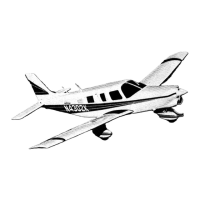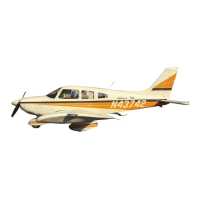SECTION 6
WEIGHT AND BALANCE
6.1 GENERAL
In order to achieve the performance and flying characteristics which are
designed into the airplane, it must be flown with the weight and center of
gravity (C.G.) position within the approved operating range (envelope).
Although the airplane offers flexibility of loading, it cannot be flown with
the maximum number of adult passengers, full fuel tanks and maximum
baggage. With the flexibility comes responsibility. The pilot must ensure that
the airplane is loaded within the loading envelope before takeoff.
Misloading carries consequences for any aircraft. An overloaded
airplane will not take off, climb or cruise as well as a properly loaded one.
The heavier the airplane is loaded, the less climb performance it will have.
Center of gravity is a determining factor in flight characteristics. If the
C.G. is too far forward in any airplane, it may be difficult to rotate for
takeoff or landing. If the C.G. is too far aft, the airplane may rotate
prematurely on takeoff or tend to pitch up during climb. Longitudinal
stability will be reduced. This can lead to inadvertent stalls and even spins;
and spin recovery becomes more difficult as the center of gravity moves aft
of the approved limit.
A properly loaded airplane, however, will perform as intended. Before
the airplane is licensed, it is weighed, and a basic empty weight and C.G.
location is computed (basic empty weight consists of the standard empty
weight of the airplane plus the optional equipment). Using the basic empty
weight and C.G. location, the pilot can easily determine the weight and C.G.
position for the loaded airplane by computing the total weight and moment
and then determining whether they are within the approved envelope.
PIPER AIRCRAFT CORPORATION SECTION 6
PA-38-112, TOMAHAWK WEIGHT AND BALANCE
ISSUED: JANUARY 20, 1978 REPORT: 2126
REVISED: MAY 10, 1982 6-1
SECTION 6
WEIGHT AND BALANCE
6.1 GENERAL
In order to achieve the performance and flying characteristics which are
designed into the airplane, it must be flown with the weight and center of
gravity (C.G.) position within the approved operating range (envelope).
Although the airplane offers flexibility of loading, it cannot be flown with
the maximum number of adult passengers, full fuel tanks and maximum
baggage. With the flexibility comes responsibility. The pilot must ensure that
the airplane is loaded within the loading envelope before takeoff.
Misloading carries consequences for any aircraft. An overloaded
airplane will not take off, climb or cruise as well as a properly loaded one.
The heavier the airplane is loaded, the less climb performance it will have.
Center of gravity is a determining factor in flight characteristics. If the
C.G. is too far forward in any airplane, it may be difficult to rotate for
takeoff or landing. If the C.G. is too far aft, the airplane may rotate
prematurely on takeoff or tend to pitch up during climb. Longitudinal
stability will be reduced. This can lead to inadvertent stalls and even spins;
and spin recovery becomes more difficult as the center of gravity moves aft
of the approved limit.
A properly loaded airplane, however, will perform as intended. Before
the airplane is licensed, it is weighed, and a basic empty weight and C.G.
location is computed (basic empty weight consists of the standard empty
weight of the airplane plus the optional equipment). Using the basic empty
weight and C.G. location, the pilot can easily determine the weight and C.G.
position for the loaded airplane by computing the total weight and moment
and then determining whether they are within the approved envelope.
PIPER AIRCRAFT CORPORATION SECTION 6
PA-38-112, TOMAHAWK WEIGHT AND BALANCE
ISSUED: JANUARY 20, 1978 REPORT: 2126
REVISED: MAY 10, 1982 6-1
